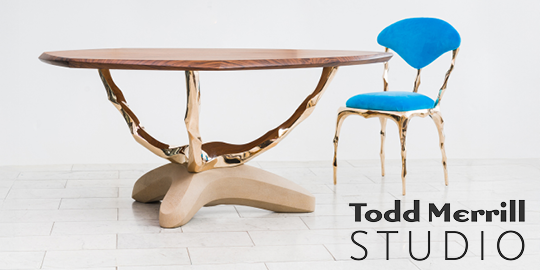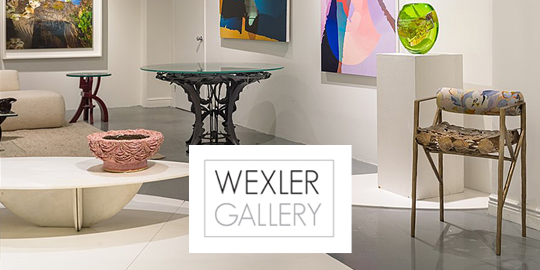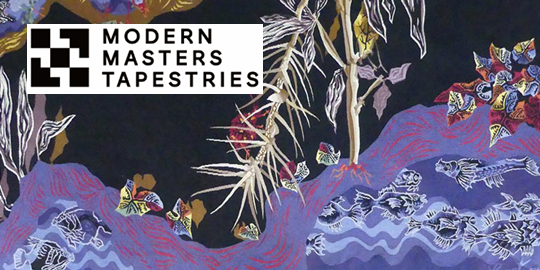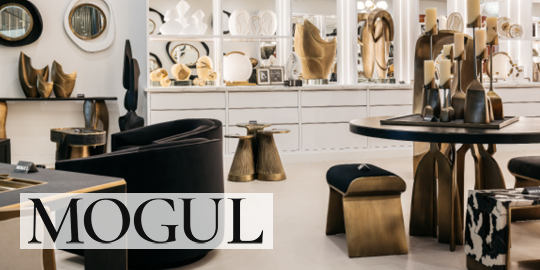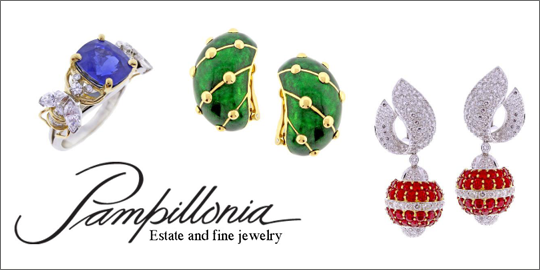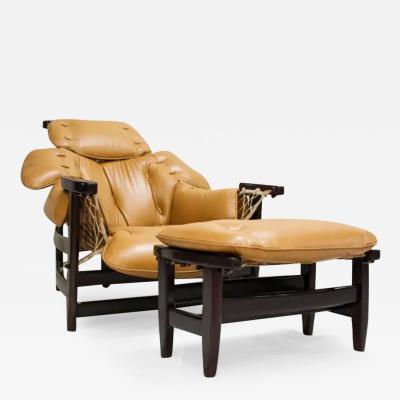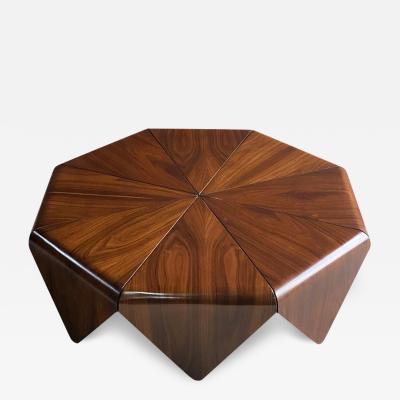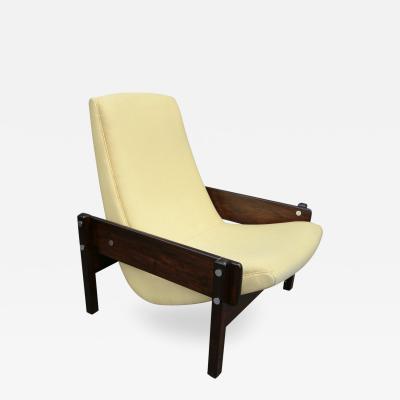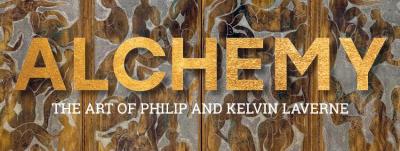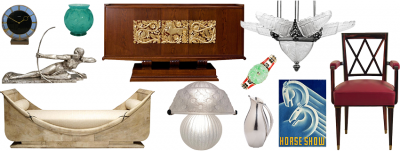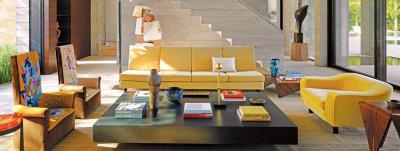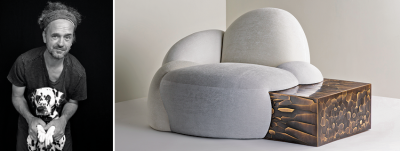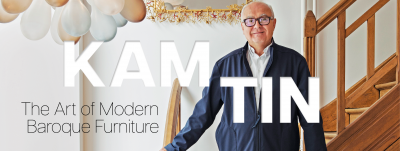Rodrigo Salem Revels in the Provenance and Sourcing of Brazilian Modern Design
Rodrigo Salem Revels
in the Provenance
and Sourcing of
Brazilian Modern Design
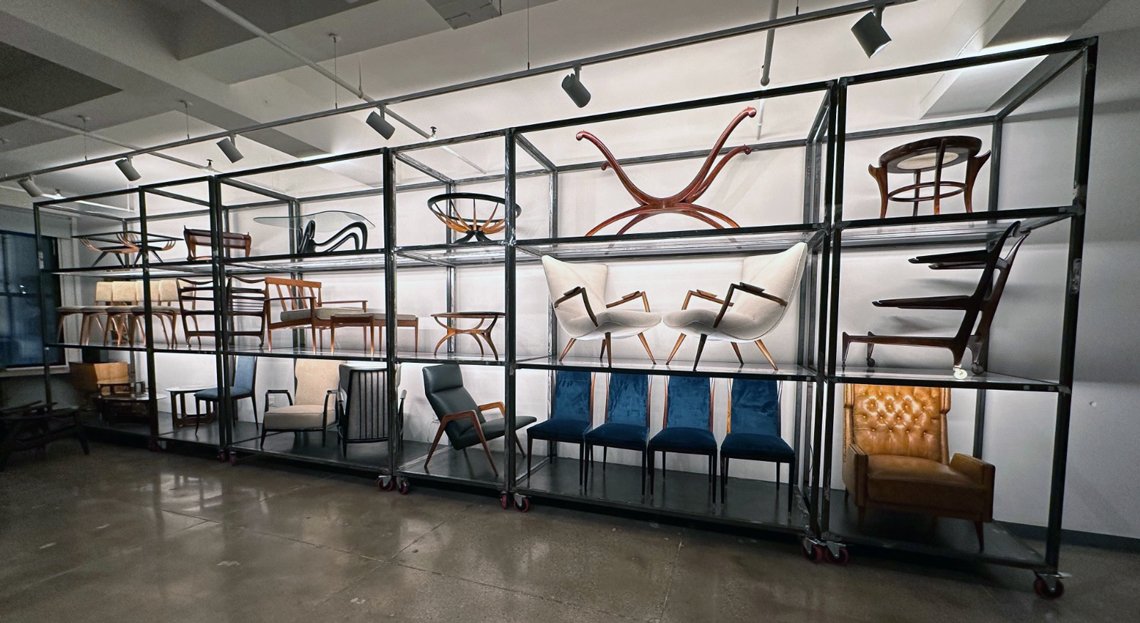 |
Rodrigo Salem’s New York showroom in Chelsea. |
All images courtesy Found Collectibles
Stepping into Rodrigo Salem’s New York City showroom, the first thing you notice is a wall of chairs, strikingly displayed in a grid of metal shelving. The shelving, Salem explains, replicates his warehouse storage facility in Rio de Janeiro where he keeps over 1,000 pieces of mid-century Brazilian design.
 |
Rodrigo Salem’s Rio de Janeiro warehouse where he stores his furniture. |
“I have been collecting this material for twenty years, but more seriously for the last three years as a dealer, and today I believe I have one of the largest and possibly best collections of modern Brazilian furniture in the United States,” he says, noting that at any one time, he has hundreds of pieces undergoing restoration.
For Salem, Brazilian modern furniture isn't just a day job, it is a life passion. He is involved in every aspect of his business from traveling across Brazil to source pieces to the process of research for authentication, based on his study of original designs and construction materials. It all ends up on display at on Incollect and at his showroom, Found Collectibles, in New York.
Salem’s attention to detail and the rigorous process he follows to bring each piece to the market has won him many fans in the design trade, among them AD100 interior designer Brian J. McCarthy. “Rodrigo’s love and passion for Brazilian mid-century furniture, his link to the collectors and collections from where they come give soul to him as a dealer. The quality and uniqueness of his pieces stand out along with the copious research he does in authenticating them which provides a rare education that is so missing. His depth of knowledge is inspiring and places squarely the importance of mid-century Brazilian design in the history of design.”
Salem’s passion for Brazilian mid-century design began while working as a corporate executive for Microsoft in 2007 and 2008. He would regularly travel to Brazil for work, 5-6 times a year, and began purchasing things for his home in Mexico City. One of his first purchases was a pair of Joaquim Tenreiro chairs made of caning and rosewood bought from a gallery in São Paulo. He still owns the chairs today.
It wasn't until May 2022 that he bought his first piece of modern Brazilian furniture with the intention of selling it, a Sergio Rodrigues console from a friend’s family. “I am an adventurer and a treasure hunter,” he says. “I moved to Rio after leaving corporate life as I wanted to start a sabbatical year to research and think about a new future. As I wandered through one of Rio de Janeiro's vibrant flea markets in search of a mid-century modern treasure, it dawned on me that I was embarking on a journey to collect and sell furniture, all while sharing the fascinating history of Brazilian Modernism with others.”
Salem estimates he has now bought over 1,500 pieces of mid-century modern Brazilian furniture by all the great names of 20th-century Brazilian design — Joaquim Tenreiro, Jorge Zalszupin, Sergio Rodrigues, Oscar Niemeyer, Giuseppe Scapinelli, Martin Eisler, Jose Zanine Caldas, Percival Lafer, and Michel Arnault, among many others.
He quickly discovered however that the business was not as straightforward as it seemed. There has been an export ban on furniture made of rosewood since the end of the 1970s, which is well-regulated in Brazil. In addition, the authenticity of original modern pieces can be difficult to ensure today, given that there is no regulation of attributions. The ateliers of some of the major designers also continue to issue re-editions of original designs, making it easier for unauthenticated or even falsified objects to appear on the market alongside genuine ones.
Salem says you must be extremely careful and know exactly what you are buying. “I've seen some crazy things,” he says. “A piece looks good, and the design is right but when you check underneath it or inside you find it has been totally remade out of wood from a cheap fruit box. There have been instances where I bought armchairs that appeared to be non-original, only to find out upon closer inspection that they are genuine pieces that have been modified over the years by previous owners. Every piece must be inspected.”
 |
An original pair of armchairs by Joaquim Tenreiro. Salem and his team restored the chairs by removing modifications made over the years, returning them to their original form. |
Salem’s hard-earned knowledge of modern Brazilian design signatures, materials, and techniques allows him to navigate these challenges strategically. “I know for instance what types of wood and kinds of craftsmanship to look for when sourcing historical pieces,” he says. “The ability to identify vintage wood and upholstery is critical in ensuring authenticity in this area.”
Understanding the different woods used in construction is also important in dating the pieces, as Brazilian furniture from the 1950s, 1960s, and 1970s each used different production methods and materials. “For example, furniture made in the fifties was crafted using high-quality hardwoods like rosewood and was completely artisanal. In the 1960s, while rosewood was still utilized, manufacturing began transitioning to more industrial and mass-production methods. By the 1970s, following the restrictions on harvesting rosewood, furniture production shifted to mass scale using non-endangered woods and newer materials such as MDF, particle board, and chrome.”
 |
The Jangada armchair with an ottoman shown at left, produced in the 1960s, was crafted from Rosewood. In contrast, a 1970s version on the right was constructed from Ipe wood, a non-endangered species. |
To illustrate the point, Salem gives two examples. The “Jangada” armchair with ottoman, designed by Jean Gillon in the sixties, was originally crafted from rosewood (on the left). While production continued into the seventies, it transitioned to other types of wood. The image on the right showcases the “Jangada” made from Ipe wood, a non-endangered species.
The second example features two credenzas created by Geraldo de Barros during the 1950s and 1970s. He notes, “The craftsmanship in the '50s was more artisanal, utilizing Brazilian rosewood. The piece from the 1970s remains a quality furniture item, but it is machine-made rather than handcrafted. The differences are evident in the finishes of the legs, joints, and hinges.”
 |
The credenza designed by Geraldo de Barros in the 1950s on the left was handcrafted by artisans from endangered rosewood. On the right, the credenza he designed in the 1970s was made from Caviuna wood and produced using machine tools. |
To identify and authenticate pieces Salem cross-references vintage press materials to ensure their authenticity and confirm that each piece comes from the correct decade. His attention to detail is his biggest strength, he says, along with a background in successful business and online digital marketing. “There are stores in Brazil selling old magazines and publications. I have gone through maybe 80 stores looking for magazines and reviewed at least 5,000 of them, page by page, to find vintage press from the time. Press means two things to Salem, he says, “it consists of advertisements for the furniture and editorial articles where you see inside homes featuring modern Brazilian design.” He scans the pages with relevant images for his records which he keeps in bound folders dedicated to each of the designers and their careers.
 |
Chaise Lounge by Pierre Weck from the 1950s. Salem, a stickler for accuracy, used vintage magazine advertising imagery from House & Garden/Brazil, June 1956 issue to guide the restoration of this piece. |
 |
| An image of these armchairs by Giuseppe Scapinelli was featured in House & Garden/Brazil, August 1958. Salem has assembled a library of vintage reference material to aid in the authentication and restoration of vintage pieces. |
Once Salem has accurately identified and then authenticated a piece of furniture, his team physically deconstructs every single piece of it to inspect the wood and upholstery to assess any additions or alterations. Two layers of upholstery were found for example on a pair of armchairs by Móveis Cimo, which he purchased. “To properly reupholster the piece and reveal its original form, the restorers had to strip away the layers of old upholstery and start fresh. They followed the original technique, materials, and style, using orange bouclé, ensuring the piece was true to its intended design.”
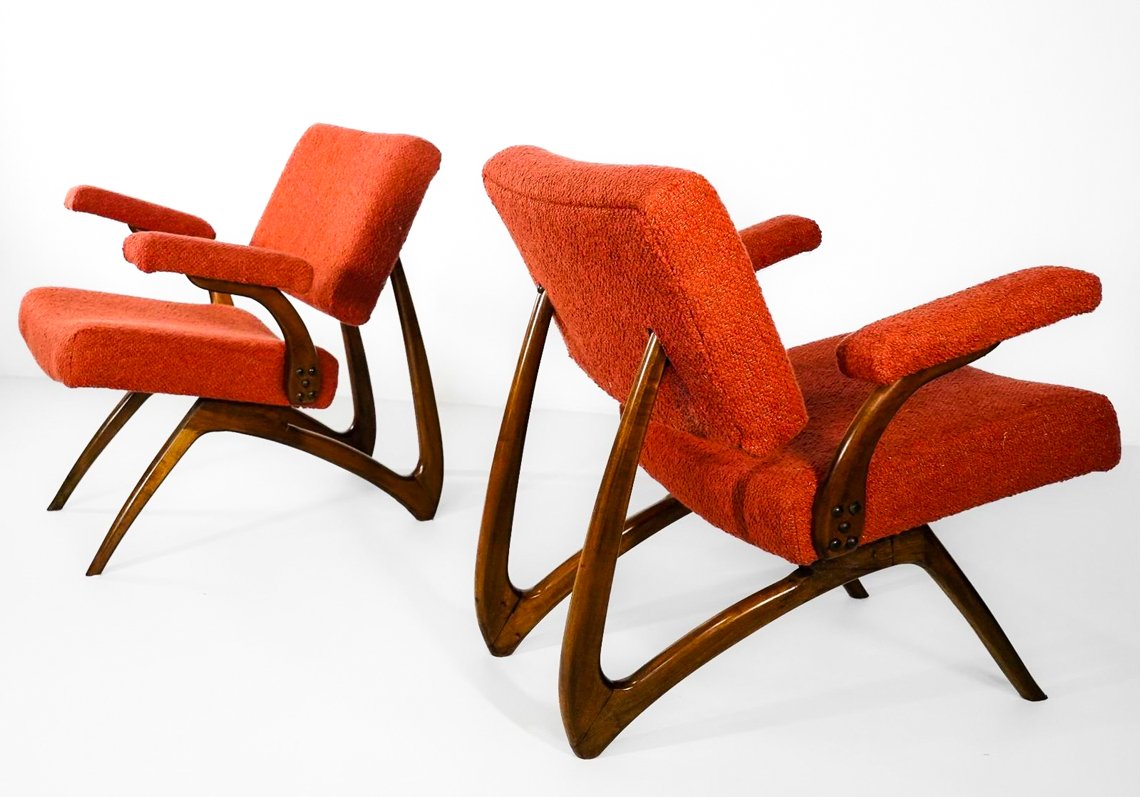 |
Armchairs by Moveis Cimo. Two layers of old upholstery were removed before restoration. |
Salem has sought out the original artisans who worked directly for the designers on the fabrication of the furniture to carry out restoration and refurbishment. “I work with two different teams in Brazil,” he says. “The wood restoration team knows everything about wood and the construction of the original furniture. Then there is the upholstery team led by Manuel. He was chief upholsterer for Sergio Rodrigues and is featured in a book on Sergio. Manuel is in his 80s and is training younger craftsmen in Brazil in the techniques and processes.”
.jpg) |
Manuel standing in front of the Mole armchair. He and his team worked for Sergio Rodrigues for ten years in the upholstery department. |
Salem is fluent in Portuguese, and this is, he believes, another business asset for him, not just in sourcing original furniture in unexpected locations across Brazil but also in understanding the finer details of the techniques and construction of the pieces. “I’m in the restoration workshops a few times a year, always talking to the artisans, learning from them. I see all the original designs, they have original tools, even records of the original forms and upholstery patterns so you can see what the furniture was meant to look like when it was first made. It is like a school”
A container load of items recently arrived at Found Collectibles’ New York gallery and includes numerous stunning pieces such as a 16 "Tall Cantú" chair set in rosewood and leather by Sergio Rodrigues from 1961. This is a prize-winning design from the IV Furniture Biennial in Italy. Then there is the “Modulo” low easy chair with ottoman in bentwood and leather by Oscar and Ana Maria Niemeyer from 1978, a rare design. He also managed to get his hands on a "Mole" armchair with an ottoman made in rosewood and leather by Rodrigues from 1957, an iconic and award-winning design. Finally, a pair of "Paulistano" armchairs from 1957, a celebrated masterpiece of Brazilian brutalist design in metal and leather by Paulo Mendes da Rocha.
 |
Set of 16 tall “Cantu" chairs by Sergio Rodrigues, 1961. |
 |
“Modulo” low easy chair with ottoman by Oscar and Ana Maria Niemeyer, 1978. |
 |
"Paulistano" armchairs by Paulo Mendes da Rocha in steel and leather, 1957. |
Salem is understandably proud of the quality and scale of his collection, and his dedication to craftsmanship, materials, and restoration processes. “To use an analogy from the technology corporate world, the artisans who work with me I think of as like the engineers and I am like the product manager,” he says. “My job is to listen and learn and then translate that product to the client in New York, or anywhere else around the world.”
His clients include collectors as well as many interior designers. The quality of the pieces Salem accesses is what distinguishes him as a dealer, according to New York-based designer Juan Montoya, who has bought pieces from Salem for his personal collection as well as for clients. "I’ve placed a collection of sculptural Brazilian furniture, including works by Sergio Rodrigues, in my 1705 home in Barichara, Colombia,” Montoya says. “Though the pieces date from the 1940s to the 1960s, they harmonize beautifully with the classical architecture, adding a timeless yet bold presence. Each piece feels like a work of art, blending seamlessly into the historical environment while standing out for its unique design. Working with Rodrigo and Found Collectibles to source these pieces has been a great experience—their expertise in Brazilian mid-century modern furniture is unparalleled. The rich textures of the wood and the organic forms bring warmth and depth to the space, creating a dialogue between past and present that elevates the home’s character."
 |
Discover More From Found Collectibles on Incollect
 |





